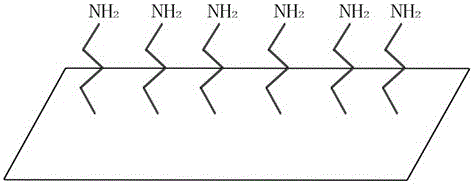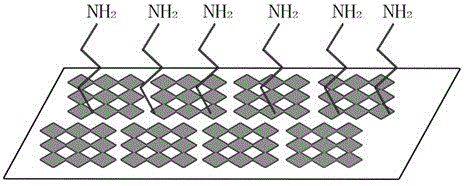Active amino-modified substrate for microarray and preparation method of active amino-modified substrate
A technology of amino modification and microarray, which is applied in the fields of medicine and biology to solve the problems of low sensitivity, improved fixation rate and poor stability
- Summary
- Abstract
- Description
- Claims
- Application Information
AI Technical Summary
Problems solved by technology
Method used
Image
Examples
Embodiment 1
[0035] A method for preparing a substrate modified with active amino groups for a microarray, comprising the steps of:
[0036] Step (1), pretreatment of the glass substrate: soak the glass substrate in a mixed solution of concentrated sulfuric acid:hydrogen peroxide = 7:3 for 13 h, and remove the residual concentrated sulfuric acid and hydrogen peroxide mixture on the surface of the glass substrate with Rinse twice with deionized water, each time for 5 minutes, and finally spin dry to obtain a pretreated glass substrate;
[0037] Step (2), aminosilanization of the glass substrate (introduction of active amino groups): the pretreated glass substrate obtained in step (1) was mixed with 1.0% 3-aminopropyldiethoxy The silane solution is fully reacted to introduce active amino groups, and then the residual 3-aminopropyldiethoxysilane solution is cleaned with 60% ethanol, and finally dried to obtain a glass substrate with aminosilanized surface;
[0038] Step (3), poly-lysine coat...
Embodiment 2
[0040] A method for preparing a substrate modified with active amino groups for a microarray, comprising the steps of:
[0041] Step (1), pretreatment of the glass substrate: soak the glass substrate in a mixed solution of concentrated sulfuric acid: hydrogen peroxide = 7:3 for 18 h, remove the residual concentrated sulfuric acid and hydrogen peroxide mixture on the surface of the glass substrate with Wash with deionized water 5 times, each time for 5 minutes, and finally spin dry to obtain the pretreated glass substrate;
[0042]Step (2), aminosilanization of the glass substrate (introduction of active amino groups): the pretreated glass substrate obtained in step (1) was mixed with 3.0% 3-aminopropyldiethoxy The silane solution is fully reacted to introduce active amino groups, and then the remaining 3-aminopropyldiethoxysilane solution is cleaned with 80% ethanol, and finally dried to obtain a glass substrate with aminosilanized surface;
[0043] Step (3), poly-lysine coat...
Embodiment 3
[0045] A method for preparing a substrate modified with active amino groups for a microarray, comprising the steps of:
[0046] Step (1), pretreatment of the glass substrate: soak the glass substrate in a mixed solution of concentrated sulfuric acid: hydrogen peroxide = 7:3 for 15 h, and remove the residual concentrated sulfuric acid and hydrogen peroxide mixture on the surface of the glass substrate with Wash with deionized water for 3 times, each time for 4min, and finally spin dry to obtain the pretreated glass substrate;
[0047] Step (2), aminosilanization of the glass substrate (introduction of active amino groups): the pretreated glass substrate obtained in step (1) was mixed with 2.5% 3-aminopropyldiethoxy The silane solution is fully reacted to introduce active amino groups, and then the residual 3-aminopropyldiethoxysilane solution is cleaned with 70% ethanol, and finally dried to obtain a glass substrate with aminosilanized surface;
[0048] Step (3), poly-lysine c...
PUM
 Login to View More
Login to View More Abstract
Description
Claims
Application Information
 Login to View More
Login to View More - R&D
- Intellectual Property
- Life Sciences
- Materials
- Tech Scout
- Unparalleled Data Quality
- Higher Quality Content
- 60% Fewer Hallucinations
Browse by: Latest US Patents, China's latest patents, Technical Efficacy Thesaurus, Application Domain, Technology Topic, Popular Technical Reports.
© 2025 PatSnap. All rights reserved.Legal|Privacy policy|Modern Slavery Act Transparency Statement|Sitemap|About US| Contact US: help@patsnap.com



